
Vehicles lined up for test drives. The event is run from the gray building at the end of the parking lot.
The Auto Journalists Association of Canada (AJAC) Car of the Year TestFest took place at Mosport Raceway, in Ontario, on October 12th and 13th, 2022.
Dozens of AJAC voting journalists from across Canada attended the two day event to drive the latest models from vehicle manufacturers. The drives lead to impressions of the new vehicles for voting to award the Canadian Car of the Year and Truck of the Year titles for 2023.
Following are driving impressions of the some of the most significant vehicles available at the TestFest this year.
Genesis GV60
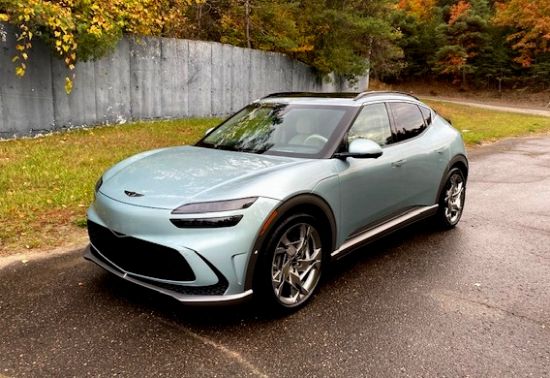
The smooth, rounded forms of the GV60 are unlike any other Genesis
Derived from the Global Modular Platform (E-GMP) that also underpins the Hyundai Ioniq5 and Kia EV6, the GV60 is built on the shorter wheelbase shared with the EV6.
The attractive rounded look of the GV60 bears little relation to its corporate cousins or other Genesis models.
A massive, horizontally-arrayed computer tablet displays vehicle functions in front of the driver. As is typical with Hyundai-Kia products, displays and controls on the dash centre stack for climate and infotainment are straightforward. A unique feature that plays on the human fascination with shiny gadgets is a console-mounted crystal half-orb that rotates 180 degrees to reveal a rotary shifter when the car is started. The GV60 is roomy and all occupants enjoy comfortable seating. Cargo space is not vast but is nicely square and deep.
With supple leather seating, a faux-suede headliner and door inserts, elegant faux metallic accents and some very interesting shapes, the Performance model driven is a great place to spend time in. On the road, the 77.4 kWh battery pack rated at 429 horsepower delivers very vivid acceleration in near silence. The brakes offer a range of regenerative settings and pedal feel is very much like conventional friction brakes. Steering is precise and nicely weighted, and handling is confident. On the smooth roads available for the test, the ride is comfortable, despite the massive 21 inch wheels.
Genesis G90
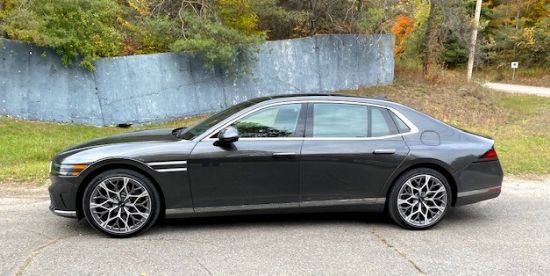
The second-generation G90 looks imposing but can’t be described as elegant due to some awkward features like the plethora of tiny windows surrounding the rear doors
The G90 is large and imposing; it displays current Genesis styling themes like the massive grille and two-bar headlamps, but can’t really be described as elegant. Inside, the G90 is a triumph. Cabin materials are impressive, from Nappa leather, vast swathes of faux suede, real alloy surfaces and great lashings of what is referred to as “forged carbon” trim.
The sole engine offered in Canada is a 3.5L-V6 turbo that also employs a 48 volt electric “supercharger” to produce 409 horsepower. Power reaches all four wheels via a conventional eight-speed automatic. Suspension is via four-wheel air springs, and the new G90 features all-wheel steering.
On the road, the G90 gains speed rapidly, and unless it is fully extended, when its engine emits muted symphonic noises, progress is defined by impressive serenity. With the air suspension, the car simply smothers road imperfections, notwithstanding the presence of massive wheels and low-profile, high-performance tires. In spite of its massive size, the G90 shrinks around you as you drive it.
Few vehicles can provide the luxury car experience that the G90 delivers with aplomb. That said, the carriage class end of the market has shifted from cars to crossovers so the market for super-luxe sedans is much smaller than it was a decade ago.
The G90 is large and imposing; it displays current Genesis styling themes like the massive grille and two-bar headlamps, but can’t really be described as elegant. Inside, the G90 is a triumph. Cabin materials are impressive, from Nappa leather, vast swathes of faux suede, real alloy surfaces and great lashings of what is referred to as “forged carbon” trim.
The sole engine offered in Canada is a 3.5L-V6 turbo that also employs a 48 volt electric “supercharger” to produce 409 horsepower. Power reaches all four wheels via a conventional eight-speed automatic. Suspension is via four-wheel air springs, and the new G90 features all-wheel steering.
On the road, the G90 gains speed rapidly, and unless it is fully extended, when its engine emits muted symphonic noises, progress is defined by impressive serenity. With the air suspension, the car simply smothers road imperfections, notwithstanding the presence of massive wheels and low-profile, high-performance tires. In spite of its massive size, the G90 shrinks around you as you drive it.
Few vehicles can provide the luxury car experience that the G90 delivers with aplomb. That said, the carriage class end of the market has shifted from cars to crossovers so the market for super-luxe sedans is much smaller than it was a decade ago.
Hyundai Elantra N
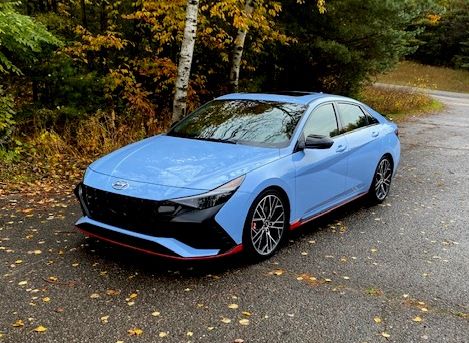
Super-dynamic styling, including the arrow-head door motif, has been embraced by buyers
Easy to confuse with the Elantra N-Line, a sporty appearance package, the performance-focussed N, powered by a 276 horsepower 2L turbo four, sits at the top of the Elantra range.
In its normal mode, the 2L turbo is smooth, flexible and spins enthusiastically. Sport mode adds some additional exhaust sizzle, and selecting “N” mode adds even more fun. Driver’s can enjoy the sport or N modes while in the mood for fun but can switch them off to access pleasing refinement when driven more sedately. The six-speed manual transmission joins a snicky, short-throw gearchange with a docile clutch. Steering is precise and beautifully weighted.
A free-standing infotainment screen sits at the top centre of the dashboard. Just below the centre dash vents are a volume knob and eight pushbuttons that control infotainment functions. The front sports seats of the N locate the driver well but never pinch. The comfortable seats are clad in a luxurious faux suede that also covers the central door panels. Though the car is low and the side windows are shallow, the driving position is very comfortable and visibility is good. Rear seat legroom is ample for this size of car.
Kia Sportage
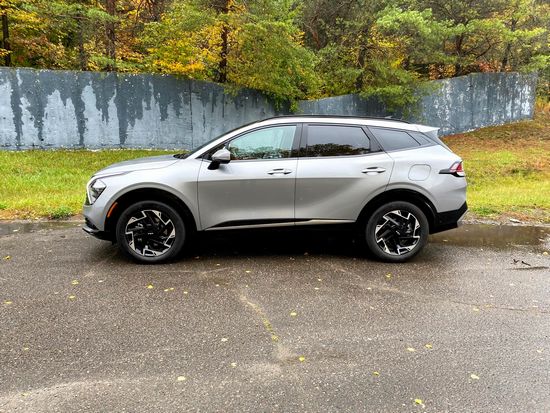
Kia abandoned the sleek elegance of the previous Sportage for something new
The Kia Sportage PHEV combines a 1.6L turbo four and an electric motor to produce 261 total horsepower. Power reaches all wheels via a six-speed automatic. The Sportage PHEV can travel up to 55 kilometres on a full charge, which takes two hours on a Level 2 charger.
On the road, the Sportage PHEV runs in full electric mode a lot of the time. Transitions from electric to gas engine mode are near seamless and quiet. The PHEV powrtrain accelerates briskly and refinement is impressive at all times, even under full acceleration. The ride is supple and handling is predictable.
Inside, the driver faces a vertically shallow but very wide computer tablet. The graphics on all the screens are very attractive. The cabin, with convincing faux alloy and piano black surfaces and two-tone vinyl upholstery, is visually compelling. Seating is comfortable front and rear and rear seat legroom is ample for larger adults. The cargo area is square and deep below the window line.
Honda HR-V

It’s hard to tell in an all-black car, but the front of the new HR-V is not the best angle to view it from. The rest of the vehicle is a neat, comtemporary styling job
The second-generation HR-V, has just gone on sale. Unlike the previous HR-V which was based on the hyper space-efficient platform of the now defunct Fit, the new HR-V is derived from the mainstream Civic and doesn’t have the tremendous packaging efficiency of its predecessor. While 125 mm longer than the last HR-V, if offers no more passenger room. The cargo area is a bit longer, but vertical height is less than last year. The gauge package and climate and audio controls are shared with the Civic. While the cabin has a number of soft-touch surfaces and nice finishes, the interior comes off as a bit stark.
The top-spec EX-L model driven was powered by the same 2L, normally aspirated four found in the LX and EX Civics. In the HR-V, the engine is loud, coarse when combined with the CVT automatic, which maintains high revs when accelerating at any pace beyond leisurely. The effect is especially noticeable when accelerating on a highway on-ramp. Road and wind noise are also both elevated. The HR-V rides well, handling is confident and braking is responsive.
Infiniti QX60
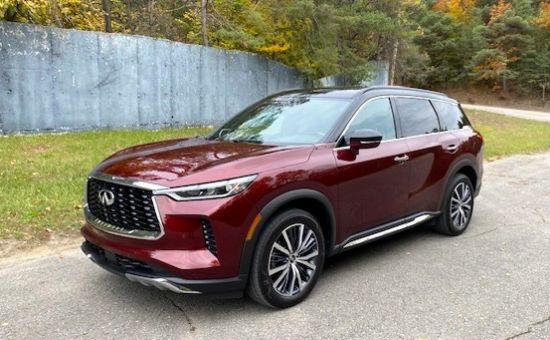
The new Infiniti QX60 has clean and elegant styling
The current QX60 that debuted for the 2022 model year features new exterior and cabin styling but it is based on a platform that first went on sale as the JX35 in 2013. Like the related Pathfinder, the update is successful and the SUV looks fresh, masking the age of the design. Among the most significant changes is the arrival of a conventional nine-speed automatic transmission in place of the previous, unreliable CVT.
Except for audio volume and setting the temperature, all other infotainment and audio functions are controlled by touch surfaces, but the different functions are separated and easy to use. The cabin is elegant and fashioned from attractive materials. Space is ample up front and in the middle row, but the third-row seat is for the small and supple. Cargo space is limited with the third-row seat up.
The normally-aspirated 3.5L-V6 is smooth, flexible and a delight to experience compared with the small-capacity turbo fours that are increasingly common in this segment. The new nine-speed automatic works unobstrusively. While not an engaging drive, the ride, handling, steering and braking are up to class standards and furnish a serene travel experience.
Lexus RX
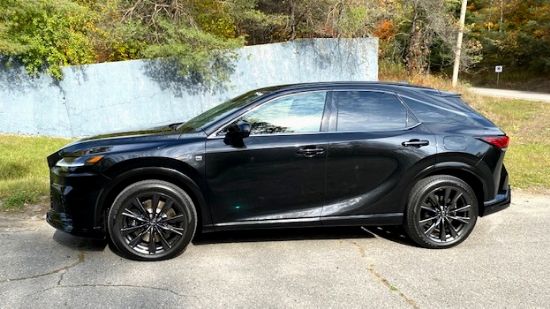
The new Lexus RX looks a mild update but Lexus states it is all-new
While its overall length and width are roughly the same, wheelbase has been increased from 2790 mm to 2850 mm.
The silky, normally-aspirated Toyota-Lexus 3.5L, has passed into history for the RX lineup. The base car, the RX 350, is powered by a 275 horsepower 2.4L turbo four. The base hybrid, the RX 350h, combines a normally-aspirated 2.5L four and electric motors to produce 246 total system horsepower. The RX 450h+ features a plug-in hybrid (PHEV) powertrain that is powered by an 18.1 kWh lithium-ion battery pack. The top model, and the one driven at AJAC, is the RX 500h, with a 2.4L turbo four hybrid and a nickel-metal hydride battery pack that produce 366 total system horsepower and 406 lb-ft of torque.
While many drivers will miss the previous V6, the new 2.4L turbo four is surprisingly smooth and sounds enthusiastic but not intrusive when extended. Power is abundant and the RX500h is fast. Unlike the RX 350h hybrid that employs a CVT, the RX500h uses a six-speed automatic transmission. Secure handling combines with a delightfully compliant ride to make the RX500h a great place to spend time in. Road noise is effectively suppressed but wind noise was higher than expected in the pre-production model driven.
What look like conventional exterior door handles are no longer mechanical door pulls, but fixed units that contain touch-sensitive electric releases. The doors release slowly and users get the impression that they are sticking. Once inside, the cabin is impressively luxurious with an attractive mix of leather and faux suede. Drivers face a digital gauge package that is easy enough to scan but its graphics look downmarket in a vehicle this expensive. Graphics on the infotainment screen, especially the navigation screen, were so faint and lacking in contrast as to border on the unusable. Seating is very comfortable front and rear, and rear seat legroom is impressive. Cargo space is good and the 40/20/40 split rear seat adds versatility.
Toyota Mirai
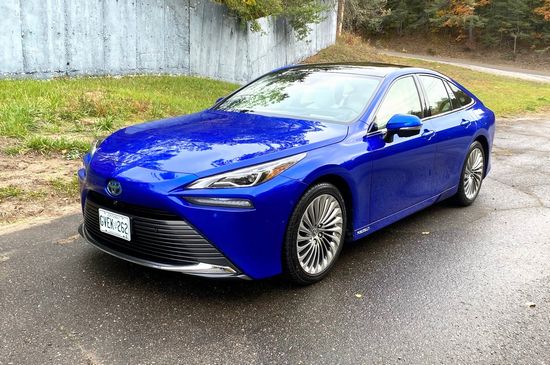
The new Mirai is a study in restrained elegance
Unlike the gawky first-generation car, the new Mirai is a sleek design. The only odd aspect is its front end that is way longer than it should in relation to the rest of the car but does contain an additional hydrogen tank.
Inside, the driver faces a TFT gauge package, to the right of which is a large, horizontal computer tablet that displays audio and climate information. The graphics of both digital displays are underwhelming. Much of the cabin is black, but the seats and a big section of the dash are white, with dark brown inserts for the door armrests and some attractive copper-toned faux alloy trim. Seating is comfortable Cabin space up front is ample, but access to the rear seat is slightly awkward and rear legroom is tighter than expected in so a large car. The conventional trunk has a nice, square shape but is not that large.
While the previous Mirai featured front-wheel drive, the new Mirai is built on Toyota’s GA-L rear-wheel drive platform that also underpins the Lexus flagship, the LS. Drive is via an electric motor mounted at the rear wheels. Compressed hydrogen is introduced into the fuel cell to create 182 horsepower and 300 lb-ft of torque. Acceleration is smooth but performance is just adequate. On the road, there is really no discernible difference in power delivery between this hydrogen fuel cell powertrain and that of a conventional electric vehicle. The Mirai’s ride is comfortable and the steering is accurate and feels crisp.
The Mirai promises over 600 kilometres of range and can be refilled in around five minutes — much faster than recharging an EV, even on a 400 volt fast charger. Hydrogen fuelling infrastructure is very restricted — just a few locations in Quebec and British Columbia, and the Mirai will only be offered in those provinces. Unlike other automakers that have abandoned hydrogen as a clean fuel alternative for the near and medium-term, Toyota and Hyundai continue to develop vehicles for the day when this may happen.
Toyota Tundra
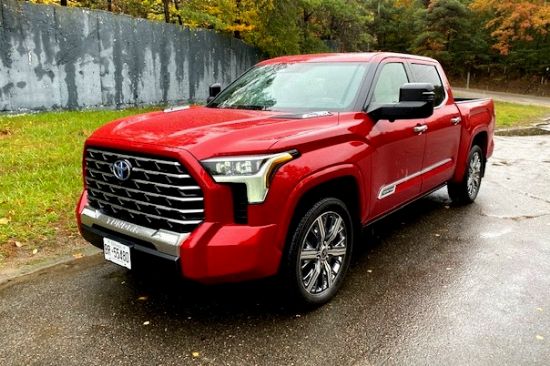
Big, bold and now a hybrid, the 2023 Tundra
New this year, the Tundra Hybrid combines the power of the 3.5L turbo V6 with a bell-housing-mounted motor-generator to create 437 horsepower and a stump-pulling 583 lb-ft of torque. Power reaches all wheels via a 10-speed automatic transmission. This powertrain pulls with great enthusiasm and response is immediate and flexible. Discreet turbo whistle accompanies any acceleration as does an inescapable exhaust rumble that varies from noticeable at a steady-state cruise to intrusive when accelerating hard. Toyota may know its customers, but the exhaust noise could be a deal-breaker for some Tundra intenders. The ride is absorbent and handling is predictable. Steering is an interesting blend of a slight looseness suited to off-roading, and precision for on-road driving.
Shabby cabins, long a Toyota truck constant, were exorcised on the super-premium, $86,000 Capstone model Toyota provided for the TestFest. There are numerous soft-touch surfaces, luxurious leather seating and an attractive two-tone colour combination. Drivers face an attractive “trucky” digital gauge package. Unfortunately the large, free-standing infotainment screen has low-contrast graphics similar to those of the Lexus NX and RX models. The base of the screen houses a series of physical toggles and buttons that control all climate functions and work well, except the ones at the far right which are a real reach for the driver. The vast and comfortable front seats are separated by a massive console with impressive oddments storage. The rear seat is very supportive and offers near-endless legroom.
The Capstone model sampled had electric steps that deploy from the rear corners when the tailgate is folded down, to facilitate access to the load bed.
Time will tell if the new more sophisticated powertrain will be as troublefree previous V8 powertrain and six-speed automatic transmission.
Subaru BRZ
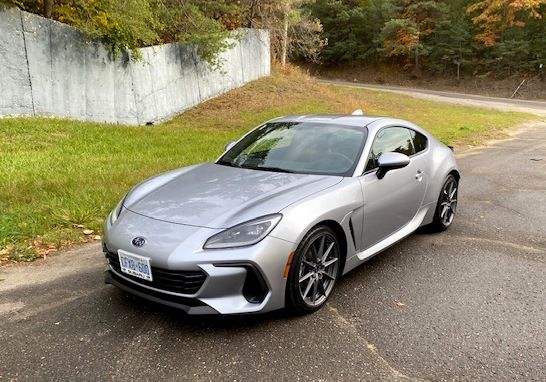
The BRZ is one terrific car to drive
The second-generation BRZ is related to the Toyota GR86; both are built in Subaru’s Gunma factory in Japan. The cars are twins, but subtle differences in appearance and specifications distinguish them.
A 2.5L, normally-aspirated flat four produces 228 horsepower. Rear drive is via either a six-speed manual transmission or a conventional six-speed automatic, which is how the BRZ sampled was equipped.
Subaru flat fours are not known for their refinement, but that of the BRZ is even noisier due to more open exhaust tuning than in Subaru’s mainstream cars. Power delivery is strong and flexible, and the car feels very lively. The six-speed automatic upshifts smoothly and downshifts rapidly. The steering is very quick and nicely weighted. Handling and grip are both excellent. Braking effort is high but the brakes are strong, with good pedal feel and no lost motion.
Getting in is a bit of a challenge for larger adults, but once inside cabin space is ample and the sports seats hold, but don’t pinch. The graphics of the gauge package and infotainment screen are disappointing, especially for what has become a rather expensive car.
Subaru WRX
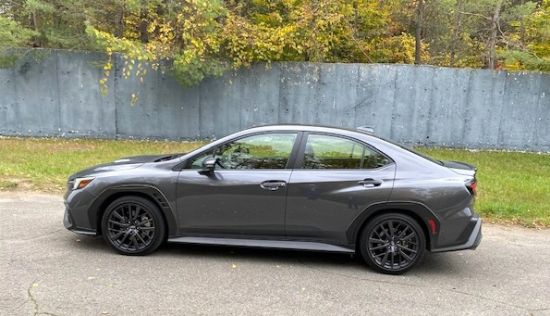
Though based on the Impreza sedan, Subaru notes that the WRX shares no exterior panels
The current Impreza debuted for the 2016 model year, but the related WRX waited until 2022 to show up. It benefits from some WRX-specific updates to Subaru’s universal SGP platform. Sharing the same wheelbase as the Impreza, the WRX is a bit wider due to its flared fenders. Supposedly, none of the exterior panels are shared with the mainstream Impreza.
Inside, the WRX uses a combination of Impreza parts and some bits from the Legacy/Outback models, like the massive, vertical touch screen. The sunshade eyebrow that sits at the top of the dash on the Impreza is deleted. With lots of soft-touch surfaces and lavish faux suede seating, the appointmentrs are attractive. Very comfortable sports seats are found up front, with a comfortable perch in back. The Impreza platform is space efficient and there is enough room for all-day comfort for four adults. Trunk space is regularly shaped and quite commodious.
Subaru swapped the 2L flat four of the last WRX for a 2.4L turbo also offered in the Outback-Legacy and Ascent. The engine produces 271 horsepower, 11 more than in the Legacy-Outback, but requires premium fuel. The big 2.4L turbo spins freely, is smooth and pulls very strongly. The six-speed manual transmission pairs a docile clutch with a gear change that is a bit clunky with long throws but never fails to find the right gear. Steering is beautifully weighted and precise, unlike the vague tillers of most Subarus. Handling defines precision and combines with a surprisingly supple ride to deliver exceptional real-world performance. Braking is confident, with great pedal feel.
Jeep Grand Cherokee
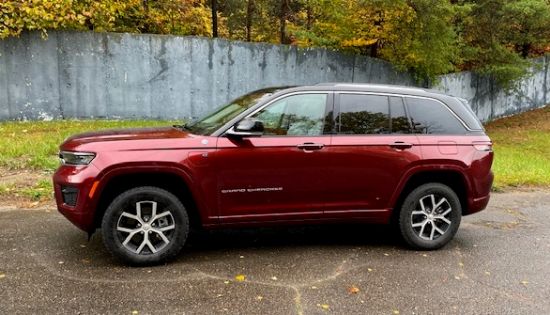
Off-road elegance, the new Grand Cherokee
The 4XE version of the Grand Cherokee is offered on the regular wheelbase version of the platform. The 4XE combines an Alfa-Romeo sourced 2L turbo four with an electric motor that Jeep refers to as eTorque. Total system output is rated at 375 horsepower.
The 4XE drives in full electric mode much of the time, with a seamless transition to the gas engine. The gas engine performs smoothly in general driving, and emits a sporty blat when pushed hard. The four-corner air suspension on the Overland trim driven delivers a plush ride and stable handling, but has lacked durability in past models. The regenerative brakes work well. The Grand Cherokee feels very stout and it is impressively quiet.
The cabin of the very-high-end Overland trim driven is chic and looks expensive, appropriate given the enormous price tag for the vehicle. Graphics of the digital gauge package lack the visual élan expected at this price. The large dash centre infotainment screen has nicely rendered graphics and some touch-sensitive controls and some conventional controls to make life easier for the driver. Seating is very comfortable and space is good up front. The Grand Cherokee welcomes large adults in the rear but not with the same stretch-out comfort as the Lexus RX.
Reliability of the 4XE drivetrain is unknown. Electrical issues are not unknown and parts shortages not uncommon.
